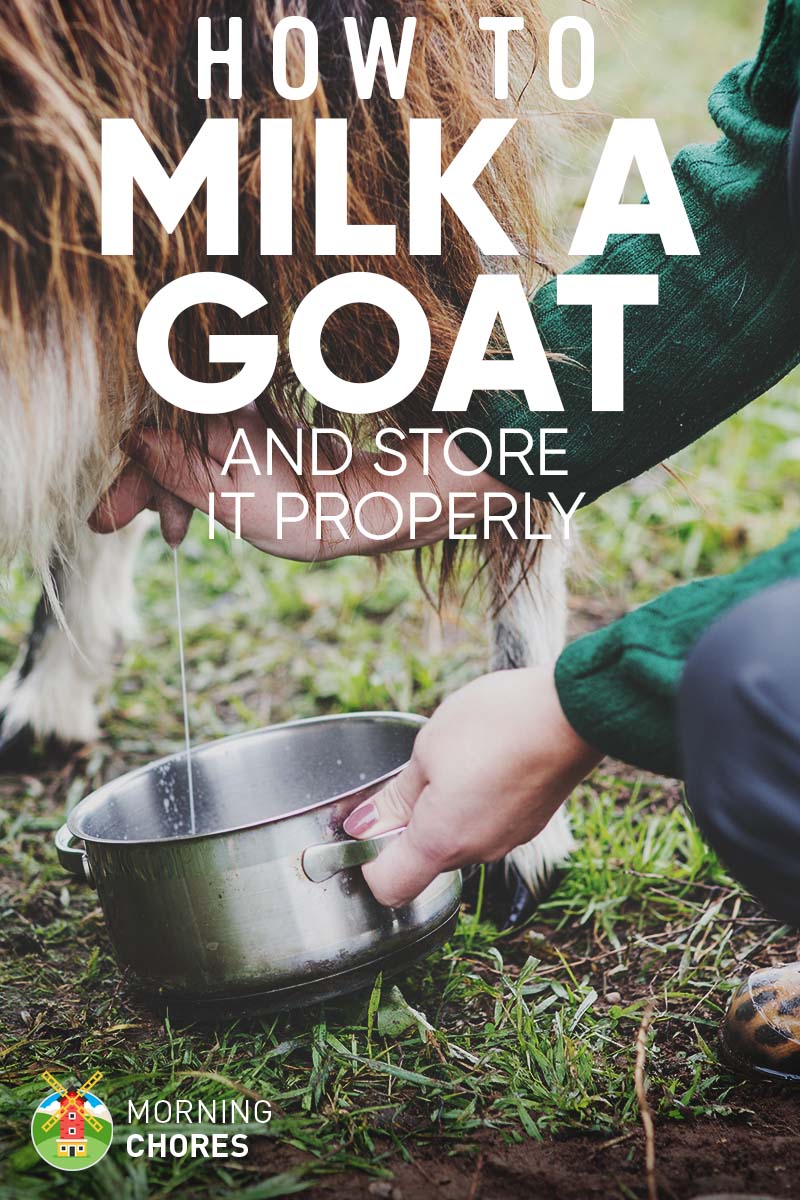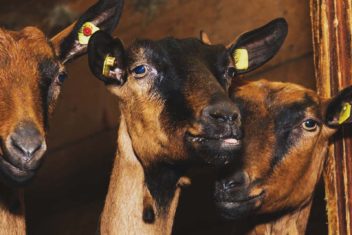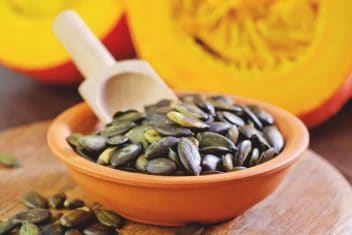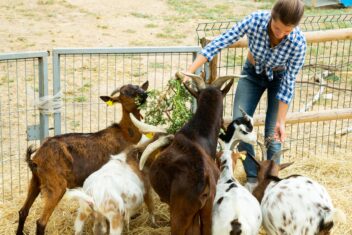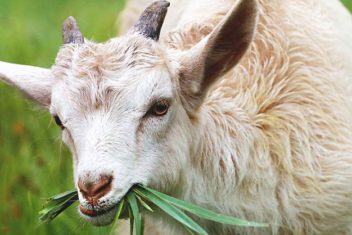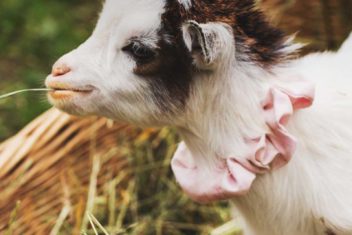Why did you invest in goats? Was it to clear your land, to have as a pet, to use as a meat source, or to raise as a dairy source? Well, for me, it was for many of the reasons I just mentioned.
I actually wanted goats because I needed a small dairy source. Plus, I thought that they’d be fun to have around while also helping us clean up our land.
So far they have been great for all of those purposes.
However, learning how to milk a goat was interesting which is why I’d like to share with you how to milk a goat properly and how to store the milk, too.
How to Milk a Goat
What You’ll Need:
- A milking stand
- Stainless steel bucket
- Supplies to wash the udder and teats
- Stainless steel strainers and milk filters
- Jars for milk storage
1. Place the Goat on the Milking Stand
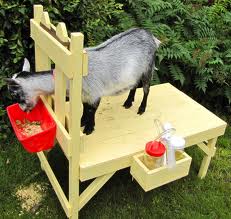
To begin, you’ll need a milking stand. You can purchase one, or you can learn how to build your own using this great resource.
Once you have your stand all ready to go, then you’ll need to secure the goat to the stand. The best way to keep your goat happy while milking is to supply them with a special treat. For some, they make homemade goat treats.
As for me, we usually use sweet feed. I don’t give it to my goats very often. So when it comes out, they are more than willing to cooperate.
After you get your goat happy and distracted, it is time to get the process moving.
2. Clean Your Hands
Your next move will be to clean your hands. Goats can get infections from open glands around their teats.
It is important to keep them as clean as possible during the process. That means, it starts with you. Which means you need to be sure to wash your hands with soapy warm water (if available.) I personally, would recommend carrying a handwashing tub out to the milking station with you.
If not, then you could always carry a little container of hand sanitizer along with you. Just be sure it doesn’t irritate the goat in any way.
3. Clean the Goat
Now, it is time to clean the goat. It is recommended to shave the goat’s udder, if possible. This will make the milking process go a little easier and smoother for you. The reason is so you can see what you are working with.
Plus, it also helps keep the milk more sanitized. The less hair you have around the udder, the less likely you’ll end up with big globs of it in your milk.
So for sanitation purposes, it is probably a good idea to go ahead and just shave the udder back as much as possible. You’ll also have to get the leg hair around the udder as well.
Aren’t sure how to do that? Well, here is another resource to help you along with the process:
After you verify that your goat’s udder is trimmed properly, you’ll need to sanitize the goat’s udder and teats. You do this by cleaning them with warm, soapy water. Then dry them off completely.
Or you can also make these udder cleaning wipes. Just be sure to dry the teats completely before milking.
4. Grab A’Hold…Properly
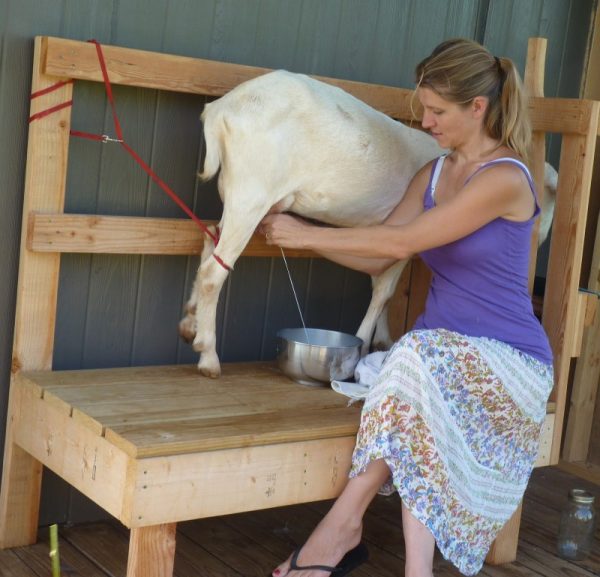

After your goat is on the stand, and you both are sanitized, you are ready to get the milking party started.
First, you’ll grab the teat, but there is a correct way of doing this. It will help you block the milk in the teat and not harm the goat (which is obviously very important.)
You properly latch to the goat by wrapping your thumb and index finger around the teat. You’ll grab about 2-inches or so into the udder. Not at the bottom of the teat. This will only cause pain for the goat, and you won’t get much milk.
As you quickly pull down, you should get a solid stream of milk. When pulling down be sure to leave your thumb and index finger in place, but you’ll squeeze your remaining fingers and the palm of your hand together as you pull down. This should pull the milk down and form a steady stream.
Before you go to town milking, get a couple of squirts of milk from each teat. You do this to see if there are any clumps or blood in the milk.
If so, then there is a good chance that your goat has mastitis. This is a resource to help you deal with or recognize mastitis in your goat.
Also, these few squirts of milk also remove any milk that was close to the surface and could potentially carry pathogens that you wouldn’t want to drink.
Once you verify that your goat’s milk is clean and good for drinking, you’re ready to move on.
5. Be Quick About It
You’ll continue milking the goat as you were in the previous step. You’ll milk 2 teats at a time until you are noticing that the teats are empty.
As you can tell, this step is pretty simple as long as you have the milking technique down pat. You’ll just be as quick as possible about milking so the goat doesn’t begin to get antsy.
6. Give the Udder a Massage
When you think that the udder is empty, you’ll gently massage it. The same way a baby goat head butts the udder in order to get more let down, you’ll be doing virtually the same thing.
After you do this, go back and milk again until you realize it is empty again. You’ll realize that the teat is empty when it becomes shriveled and flaccid. After it becomes emptied the second time, you’ve completed the actual milking of the goat.
7. Filter the Milk
After you have all of your milk, you’ll need to strain it through the filter and into glass jars. The faster you do this process the better quality of your milk, usually.
So this step is pretty self-explanatory. You’ll use the strainer and filter I mentioned you would need. Hold it over the glass jars and empty the milk from the bucket until the jar is full.
Then you’ll repeat the same thing until all of the milk is in glass jars.
8. Clean the Goat…Again
The goat’s health is of the upmost importance in this process. If your goat isn’t healthy, it obviously stops your milk source.
Plus, it could also impact the health of your herd. So you need to do everything possible to keep your goat healthy. Keeping the goat sanitized after each milking session is a great way of caring for their health.
You can do this by spraying the goat’s udder and teats with a sanitizing spray or by dipping the teats into a sanitizing mixture. This usually can be purchased at an agricultural store. The only thing is that if you use the dip, it is a mixture that is poured into a cup.
Then you dip the teat into the cup. Be sure that each goat is given their own cup so you don’t cross-contaminate.
9. Return the Goat and Clean Up
After your goat has been sanitized, you’ll need to return her to the herd. It is important to feed her and give her ample amounts of water. Not only will this replenish her, but it also encourages her to remain standing.
It is important for her to remain standing because you don’t want an open teat to be open to bacteria right after milking.
Then you’ll work on cleaning up your milking gear. You’ll need to rinse your bucket, filter, and strainer.
Next, you’ll wash them in warm, soapy water. Then disinfect them. This can be done in two ways. You can make a diluted bleach mixture and spray them down with it.
However, be sure to wipe them, or you can rinse them with boiling water. After you finish the sanitation process, allow them to air dry.
10. Practice Makes Perfect
Now, if you happen to find that you are struggling with the milking technique, there is a great way to practice. You’ll fill a rubber glove with water and then tie it off.
Next, you’ll practice by placing your thumb and index finger in the right position. Then work on squeezing your other fingers and your palm together. This should begin forcing the water down the glove.
You can do this over and over acting as though you are milking a goat. This should help you with proper technique and to gain milking speed.
How to Properly Store the Milk
1. Keep Your Equipment CLEAN!
As discussed above, you’ll need to clean your milking equipment properly. Also, be sure to use a seamless bucket for milking. That way nothing can hide in any creases of the bucket.
Basically, avoid any film being left over in any of your equipment as this can quickly become a breeding ground for bacteria. This is not safe to use for your consumption, and you don’t want anything contaminated in the milking area either.
2. Filter ASAP
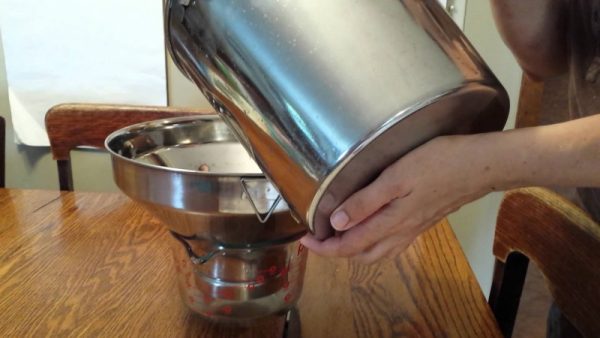

The faster you filter, the better quality of the milk. That way you don’t have raw milk that has just been hanging out.
Call me crazy, but I don’t like dairy products just left sitting around. It makes me nervous about their quality and my consumption.
Just do everyone a favor and make it a habit to filter and strain the milk during the milking process.
3. Chill the Milk ASAP
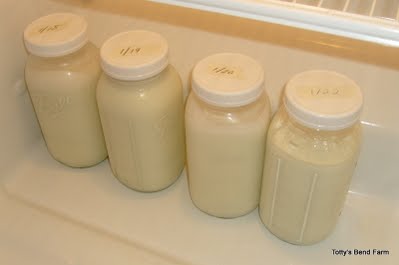
The more you consistently keep goat’s milk cold, the better it tastes, and the longer it remains fresh. Most people say goat milk is best at 40°F or below. I would just say the colder you keep it the better.
However, a lot of fridges won’t reach below 40°F. If that is all you have, then just know that your milk will still be okay, but it probably won’t last more than a week. (Maybe a little less.)
However, if you have a smaller fridge that gets colder, or if you have a spring house, then you might find that it gets below 40°F and will probably make your milk lasts twice as long as it would in a traditional fridge.
So just mess around with the temperatures that you keep your milk at. You will find what degrees works best for freshness with the kitchen appliance that you have. However, just be sure that the milk does not go above 40°F for safety purposes.
Plus, remember, the faster you get the milk to the fridge the colder it stays so that will certainly help freshness and taste.
4. Glass is Your Friend
You’ll store your milk in glass jars. Glass is easier to sanitize and make sure that you don’t have any left-over remnants of previously-stored milk.
However, I would recommend investing in the BPA free plastic storage lids to match the glass jars. The reason is that metal lids have a tendency to rust when wet.
If you use metal lids, be sure to use a fresh lid with each milking. Otherwise, invest in lids like these.
5. Kick the Boys Out
Billy goats impress their lady friends with their musky smell. When they are in rut, boy will they stink, but the ladies love them!
However, goats are easily impacted by pheromones. When the ladies smell the billy goat’s pheromone he is putting off (and trying his best to impress them with) their hormones flare up like a teenage girl’s would over the star quarterback.
Unfortunately, this can impact the quality of their milk and leave it with a musky tinge. If this is the case, then you’ll need to separate your billy goats from the females unless they are breeding.
Still, this will be your call. Not everyone has this result so if you keep your goats together, you might want to give milking a try the way things are, and if you need to make housing modifications then at least you’ll know.
Hopefully, this has been helpful in explaining how to milk a goat and how to use your goats for more than brush clearing. Their milk is very good for you and can be used for lots of different things.
